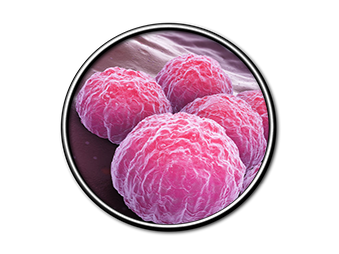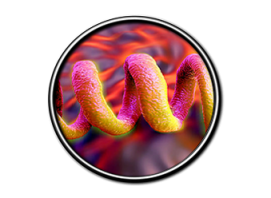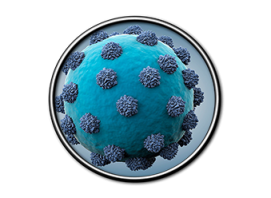Chlamydia
Chlamydia is a common sexually transmitted disease (STD) that can be easily cured. If left untreated, chlamydia can make it difficult for a woman to get pregnant.
What is chlamydia?
Chlamydia is a common sexually transmitted disease (STD) caused by infection with Chlamydia trachomatis. It can cause cervicitis in women and urethritis and proctitis in both men and women. Chlamydial infections in women can lead to serious consequences including pelvic inflammatory disease (PID), tubal factor infertility, ectopic pregnancy, and chronic pelvic pain. Lymphogranuloma venereum (LGV), another type of STD caused by different serovars of the same bacterium, occurs commonly in the developing world, and has more recently emerged as a cause of outbreaks of proctitis among men who have sex with men (MSM) worldwide.1,2
How common is chlamydia?
Chlamydia is the most frequently reported bacterial sexually transmitted infection in the United States.3 In 2017, 1,708,569 cases of chlamydia were reported to CDC from 50 states and the District of Columbia,3 but an estimated 2.86 million infections occur annually.4 A large number of cases are not reported because most people with chlamydia are asymptomatic and do not seek testing. Chlamydia is most common among young people. Almost two-thirds of new chlamydia infections occur among youth aged 15-24 years.4 It is estimated that 1 in 20 sexually active young women aged 14-24 years has chlamydia.5
Substantial racial/ethnic disparities in chlamydial infection exist, with prevalence among non-Hispanic blacks 5.6 times the prevalence among non-Hispanic whites.3 Chlamydia is also common among men who have sex with men (MSM). Among MSM screened for rectal chlamydial infection, positivity has ranged from 3.0% to 10.5%.6,7 Among MSM screened for pharyngeal chlamydial infection, positivity has ranged from 0.5% to 2.3%.7.8
How do people get chlamydia?
Chlamydia is transmitted through sexual contact with the penis, vagina, mouth, or anus of an infected partner. Ejaculation does not have to occur for chlamydia to be transmitted or acquired. Chlamydia can also be spread perinatally from an untreated mother to her baby during childbirth, resulting in ophthalmia neonatorum (conjunctivitis) or pneumonia in some exposed infants. In published prospective studies, chlamydial conjunctivitis has been identified in 18-44% and chlamydial pneumonia in 3-16% of infants born to women with untreated chlamydial cervical infection at the time of delivery.9-12 While rectal or genital chlamydial infection has been shown to persist one year or longer in infants infected at birth,13 the possibility of sexual abuse should be considered in prepubertal children beyond the neonatal period with vaginal, urethral, or rectal chlamydial infection.
People who have had chlamydia and have been treated may get infected again if they have sexual contact with a person infected with chlamydia.14
Who is at risk for chlamydia?
Any sexually active person can be infected with chlamydia. It is a very common STD, especially among young people.3 It is estimated that 1 in 20 sexually active young women aged 14-24 years has chlamydia.5
Sexually active young people are at high risk of acquiring chlamydia for a combination of behavioral, biological, and cultural reasons. Some young people don’t use condoms consistently.15 Some adolescents may move from one monogamous relationship to the next more rapidly than the likely infectivity period of chlamydia, thus increasing risk of transmission.16Teenage girls and young women may have cervical ectopy (where cells from the endocervix are present on the ectocervix).17Cervical ectopy may increase susceptibility to chlamydial infection. The higher prevalence of chlamydia among young people also may reflect multiple barriers to accessing STD prevention services, such as lack of transportation, cost, and perceived stigma.16-20
Men who have sex with men (MSM) are also at risk for chlamydial infection since chlamydia can be transmitted by oral or anal sex. Among MSM screened for rectal chlamydial infection, positivity has ranged from 3.0% to 10.5%.6.7 Among MSM screened for pharyngeal chlamydial infection, positivity has ranged from 0.5% to 2.3%.7.8
What are the symptoms of chlamydia?
Chlamydia is known as a ‘silent’ infection because most infected people are asymptomatic and lack abnormal physical examination findings. Estimates of the proportion of chlamydia-infected people who develop symptoms vary by setting and study methodology; two published studies that incorporated modeling techniques to address limitations of point prevalence surveys estimated that only about 10% of men and 5-30% of women with laboratory-confirmed chlamydial infection develop symptoms.21.22 The incubation period of chlamydia is poorly defined. However, given the relatively slow replication cycle of the organism, symptoms may not appear until several weeks after exposure in those persons who develop symptoms.
In women, the bacteria initially infect the cervix, where the infection may cause signs and symptoms of cervicitis (e.g., mucopurulent endocervical discharge, easily induced endocervical bleeding), and sometimes the urethra, which may result in signs and symptoms of urethritis (e.g., pyuria, dysuria, urinary frequency). Infection can spread from the cervix to the upper reproductive tract (i.e., uterus, fallopian tubes), causing pelvic inflammatory disease (PID), which may be asymptomatic (“subclinical PID”)23 or acute, with typical symptoms of abdominal and/or pelvic pain, along with signs of cervical motion tenderness, and uterine or adnexal tenderness on examination.
Men who are symptomatic typically have urethritis, with a mucoid or watery urethral discharge and dysuria. A minority of infected men develop epididymitis (with or without symptomatic urethritis), presenting with unilateral testicular pain, tenderness, and swelling.24
Chlamydia can infect the rectum in men and women, either directly (through receptive anal sex), or possibly via spread from the cervix and vagina in a woman with cervical chlamydial infection.25, 26 While these infections are often asymptomatic, they can cause symptoms of proctitis (e.g., rectal pain, discharge, and/or bleeding).26-28
Sexually acquired chlamydial conjunctivitis can occur in both men and women through contact with infected genital secretions.29
While chlamydia can also be found in the throats of women and men having oral sex with an infected partner, it is typically asymptomatic and not thought to be an important cause of pharyngitis.26
What complications can result from chlamydial infection?
The initial damage that chlamydia causes often goes unnoticed. However, chlamydial infections can lead to serious health problems with both short- and long-term consequences.
In women, untreated chlamydia can spread into the uterus or fallopian tubes and cause pelvic inflammatory disease (PID). Symptomatic PID occurs in about 10 to 15 percent of women with untreated chlamydia.30,31 However, chlamydia can also cause subclinical inflammation of the upper genital tract (“subclinical PID”). Both acute and subclinical PID can cause permanent damage to the fallopian tubes, uterus, and surrounding tissues. The damage can lead to chronic pelvic pain, tubal factor infertility, and potentially fatal ectopic pregnancy.32,33
Some patients with chlamydial PID develop perihepatitis, or “Fitz-Hugh-Curtis Syndrome”, an inflammation of the liver capsule and surrounding peritoneum, which is associated with right upper quadrant pain.
In pregnant women, untreated chlamydia has been associated with pre-term delivery,34 as well as ophthalmia neonatorum (conjunctivitis) and pneumonia in the newborn.
Reactive arthritis can occur in men and women following symptomatic or asymptomatic chlamydial infection, sometimes as part of a triad of symptoms (with urethritis and conjunctivitis) formerly referred to as Reiter’s Syndrome.35
What about chlamydia and HIV?
Untreated chlamydia may increase a person’s chances of acquiring or transmitting HIV – the virus that causes AIDS.36
How does chlamydia affect a pregnant woman and her baby?
In pregnant women, untreated chlamydia has been associated with pre-term delivery,34 as well as ophthalmia neonatorum (conjunctivitis) and pneumonia in the newborn. In published prospective studies, chlamydial conjunctivitis has been identified in 18-44% and chlamydial pneumonia in 3-16% of infants born to women with untreated chlamydial cervical infection at the time of delivery.9-12 Neonatal prophylaxis against gonococcal conjunctivitis routinely performed at birth does not effectively prevent chlamydial conjunctivitis.37-39
Screening and treatment of chlamydia in pregnant women is the best method for preventing neonatal chlamydial disease. All pregnant women should be screened for chlamydia at their first prenatal visit. Pregnant women under 25 and those at increased risk for chlamydia (e.g., women who have a new or more than one sex partner) should be screened again in their third trimester. Pregnant women with chlamydial infection should be retested 3 weeks and 3 months after completion of recommended therapy.40
Who should be tested for chlamydia?
Any sexually active person can be infected with chlamydia. Anyone with genital symptoms such as discharge, burning during urination, unusual sores, or rash should refrain from having sex until they are able to see a health care provider about their symptoms.
Also, anyone with an oral, anal, or vaginal sex partner who has been recently diagnosed with an STD should see a health care provider for evaluation.
Because chlamydia is usually asymptomatic, screening is necessary to identify most infections. Screening programs have been demonstrated to reduce rates of adverse sequelae in women.31,41 CDC recommends yearly chlamydia screening of all sexually active women younger than 25, as well as older women with risk factors such as new or multiple partners, or a sex partner who has a sexually transmitted infection.40 Pregnant women under 25 or older pregnant women at increased risk for chlamydia (e.g., women who have a new or more than one sex partner) should be screened during their first prenatal visit and again during their third trimester.40 Women diagnosed with chlamydial infection should be retested approximately 3 months after treatment.40 Any woman who is sexually active should discuss her risk factors with a health care provider who can then determine if more frequent screening is necessary.
Routine screening is not recommended for men. However, the screening of sexually active young men should be considered in clinical settings with a high prevalence of chlamydia (e.g., adolescent clinics, correctional facilities, and STD clinics) when resources permit and do not hinder screening efforts in women.40
Sexually active men who have sex with men (MSM) who had insertive intercourse should be screened for urethral chlamydial infection and MSM who had receptive anal intercourse should be screened for rectal infection at least annually; screening for pharyngeal infection is not recommended.. More frequent chlamydia screening at 3-month intervals is indicated for MSM, including those with HIV infection, if risk behaviors persist or if they or their sexual partners have multiple partners.40
At the initial HIV care visit, providers should test all sexually active persons with HIV infection for chlamydia and perform testing at least annually during the course of HIV care. A patient’s health care provider might determine more frequent screening is necessary, based on the patient’s risk factors.42
How is chlamydia diagnosed?
There are a number of diagnostic tests for chlamydia, including nucleic acid amplification tests (NAATs), cell culture, and others. NAATs are the most sensitive tests, and can be performed on easily obtainable specimens such as vaginal swabs (either clinician- or patient-collected) or urine.43
Vaginal swabs, either patient- or clinician-collected, are the optimal specimen to screen for genital chlamydia using NAATs in women; urine is the specimen of choice for men, and is an effective alternative specimen type for women.43 Self-collected vaginal swab specimens perform at least as well as other approved specimens using NAATs.44 In addition, patients may prefer self-collected vaginal swabs or urine-based screening to the more invasive endocervical or urethral swab specimens.45Adolescent girls may be particularly good candidates for self-collected vaginal swab- or urine-based screening because pelvic exams are not indicated if they are asymptomatic.
Chlamydial culture can be used for rectal or pharyngeal specimens, but is not widely available. NAATs have demonstrated improved sensitivity and specificity compared with culture for the detection of C. trachomatis at non-genital sites46-48 Most tests, including NAATs, are not FDA-cleared for use with rectal or pharyngeal swab specimens; however, NAATS have demonstrated improved sensitivity and specificity compared with culture for the detection of C. trachomatis at rectal sites46-48 and however, some laboratories have met regulatory requirements and have validated NAAT testing on rectal and pharyngeal swab specimens.
What is the treatment for chlamydia?
Chlamydia can be easily cured with antibiotics. HIV-positive persons with chlamydia should receive the same treatment as those who are HIV-negative.
Persons with chlamydia should abstain from sexual activity for 7 days after single dose antibiotics or until completion of a 7-day course of antibiotics, to prevent spreading the infection to partners. It is important to take all of the medication prescribed to cure chlamydia. Medication for chlamydia should not be shared with anyone. Although medication will cure the infection, it will not repair any permanent damage done by the disease. If a person’s symptoms continue for more than a few days after receiving treatment, he or she should return to a health care provider to be reevaluated.
Repeat infection with chlamydia is common.49 Women whose sex partners have not been appropriately treated are at high risk for re-infection. Having multiple chlamydial infections increases a woman’s risk of serious reproductive health complications, including pelvic inflammatory disease and ectopic pregnancy.50,51 Women and men with chlamydia should be retested about three months after treatment of an initial infection, regardless of whether they believe that their sex partners were successfully treated.40
Infants infected with chlamydia may develop ophthalmia neonatorum (conjunctivitis) and/or pneumonia.10 Chlamydial infection in infants can be treated with antibiotics.
What about partners?
If a person has been diagnosed and treated for chlamydia, he or she should tell all recent anal, vaginal, or oral sex partners (all sex partners within 60 days before the onset of symptoms or diagnosis) so they can see a health care provider and be treated. This will reduce the risk that the sex partners will develop serious complications from chlamydia and will also reduce the person’s risk of becoming re-infected. A person with chlamydia and all of his or her sex partners must avoid having sex until they have completed their treatment for chlamydia (i.e., seven days after single dose antibiotics or until completion of a seven-day course of antibiotics) and until they no longer have symptoms. For tips on talking to partners about sex and STD testing, visit www.gytnow.org/talking-to-your-partner
To help get partners treated quickly, healthcare providers in some states may give infected individuals extra medicine or prescriptions to give to their sex partners. This is called expedited partner therapy or EPT. In published clinical trials comparing EPT to traditional patient referral (i.e., asking the patient to refer their partners in for treatment), EPT was associated with fewer persistent or recurrent chlamydial infections in the index patient, and a larger reported number of partners treated.52 For providers, EPT represents an additional strategy for partner management of persons with chlamydial infection; partners should still be encouraged to seek medical evaluation, regardless of whether they receive EPT. To obtain further information regarding EPT, including the legal status of EPT in a specific area, see the Legal Status of Expedited Partner Therapy.
How can chlamydia be prevented?
Latex male condoms, when used consistently and correctly, can reduce the risk of getting or giving chlamydia.53 The surest way to avoid chlamydia is to abstain from vaginal, anal, and oral sex, or to be in a long-term mutually monogamous relationship with a partner who has been tested and is known to be uninfected.





